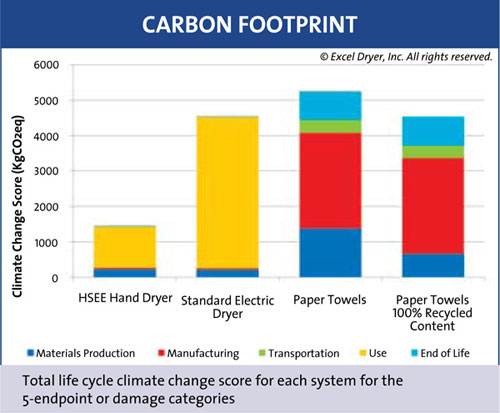Throw in the Towel: High-Speed, Energy-Efficient Hand Dryers Win Hands Down
Paying Attention to Details
How a manufacturer balances the energy use, motor speed, and amount of heat not only makes for a more or less successful drying experience, but it also impacts what may seem to be unrelated issues such as maintenance, hygiene, useful life, and suitability for a particular application. There are significant differences among the products in this 21st century-class of dryers, including:
• Conventional or trough-style design. Each manufacturer chooses between either the 'traditional' design approach - with the hands positioned under the air outlet or the "troughstyle" approach - where the user puts his/her hands into a trough or enclosure of some sort.
• Hygiene and vandalism. These fundamental design decisions, in turn, can lead to hygiene and vandalism issues, both critical to K-12 schools and other public facilities. Trough-style designs can collect excess water from the user's hands in the trough creating a cool damp environment which bacteria needs to grow and a hygiene issue can result. The trough area can also provide a vandalism opportunity for a prankster to use his/her creativity to introduce another type of liquid that might require maintenance staff to remove and clean or could even necessitate a repair. Even though some 'trough-style' units filter the air that blows out of it, unless the trough area is free of all excess used water and debris, it is just filtered air blowing into unfiltered, perhaps contaminated air, which then swirls around the hands as they dry, making it less sanitary than a conventional design.
Additionally, the design of the motion sensor can prevent or create an opportunity for damage from moisture or vandalism. A completely sealed sensor and control assembly defends against both.

• Useful life. Each manufacturer has its own unique approach, to the design and speed of the motor and the necessary heat required to achieve a fast and a "completely dry" experience. The balance of these factors the manufacturers chose affect the useful life as well as scheduled maintenance, and likelihood of repair of a unit. An RPM rate that is too high can lead to burn outs and a short lifespan, while an RPM rate that is too low can lead to an inefficient or ineffective drying experience.
• Maintenance, service, or repair. Each manufacturer creates a complete system that is more or less maintenance free. A unit's design, components, and assembly determine the level of expertise and how much effort is required to get inside the unit to maintain, service, or repair it, or replace a part. What's required to get inside the machine? Is it serviceable on the wall or must it be removed? Can you do (some) repairs with your staff or must it be sent to a service center?
• Drying position. The 'trough-style' design used by some manufacturers requires the user to place her hands into the dryer. This may be an issue for disabled persons, school children of various heights, of individuals who may be leery of putting their hands into a dryer.
• Noise. With high-speed air comes a greater amount of sound. HSEE hand dryers will add some decibels to the environment, but with flushing toilets, running faucets, and the chance to talk in a normal tone with others, this is not usually a concern for most schools or other public restrooms. Some manufacturers are offering product enhancements to address concerns for sound-sensitive areas. Examples include an air speed controller that adjusts the speed and sound level of the dryer and noise reduction nozzles that are retrofittable and can help significantly reduce the dryer’s decibel level.
• Cost and savings. This benefit includes several components and is a variable, dependent on your dryer selection. Reduced energy use and no paper towels to buy are obvious financial benefits over conventional dryers and paper towel dispensers respectively. But initial cost of the new technology varies among manufacturers, which affects how quickly the realized savings can payback that cost. A somewhat hidden cost, but real nonetheless, is the labor cost for required service, scheduled maintenance, and repair by your staff and/or an authorized provider.









